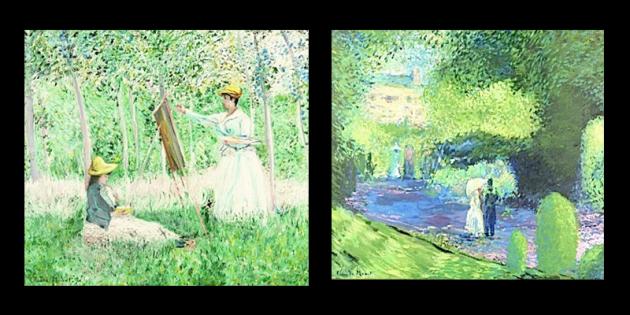Two oil paintings attributed to the renowned Hungarian art forger Elmyr de Hory have been witdrawn from sale at a New Zealand auction house and reattributed, after experts stated that they were fake fakes. The oil paintings which were pastiche renderings of Claude Monet’s At Giverny and In the Woods at Giverny were thought to be by the greatest art forger of the 20th century, but turned out to be painted by the London bookmaker, Ken Talbot.
Cordy’s auction house is now offering the two accomplished paintings as after Elmyr de Hory. Scholar Mark Forgy declared the original attribution as incorrect. The idea of someone faking de Hory’s own forgeries “came up only one time” in conversation with the artist, Mr Forgy says. “We both contemplated that for a moment and then laughed at the far-fetched notion.” The two paintings are now being advertised as “Fakes of fake Claude Monets”, the auction website reports. “We were astonished to find that there was a market in faking faker’s art works,” says auctioneer Andrew Grigg. He says they will now alert others in the business to be aware of the con”.
Elmyr de Hory was born Hoffmann Elemér Albert Budapest, April 14, 1906 – Ibiza, December 11, 1976. He was a Hungarian-born painter and art forger who is said to have sold over a thousand forgeries to by Matisse, Monet, Picasso, Modigliani and Cezanne to reputable art garnered Clifford Irving book, Fake, and from F for Fake (1974), a documentary essay film by Orson Welles.
On arriving in Paris, Elmyr de Hory attempted to make an honest living as an artist, but soon discovered that he had an uncanny ability to copy the works of noted painters. So good were his copies that many of his friends believed them to be genuine; in 1946 Elmyr de Hory sold a reproduction of a Picasso to a British woman who took it for an original. He began to sell his Picasso reproductions to art galleries, claiming that they were what remained of his family’s estate. Galleries took the paintings and paid Elmyr de Hory the equivalent of (USD) $100 to $400 (circa 1947) per painting. Like most successful art forgers, rather than attempting to copy existing works by celebrated artists, he only painted original works in their style, which made the forgeries much harder to detect. That same year Elmyr de Hory formed a partnership with Jacques Chamberlin, who later became his art dealer. They toured Europe and South America selling the forgeries until de Hory discovered that, although they were supposed to share the profits equally, Chamberlin had kept most of the money. He ended the relationship and resumed the tour alone. In 1947 Elmyr de Hory visited the United States on a three-month visa and decided to stay there, moving between New York City and Los Angeles.

